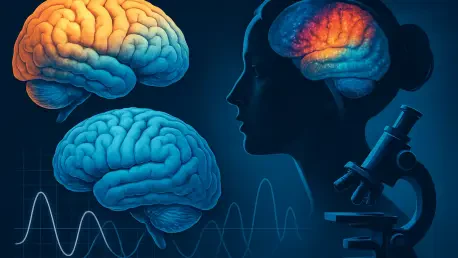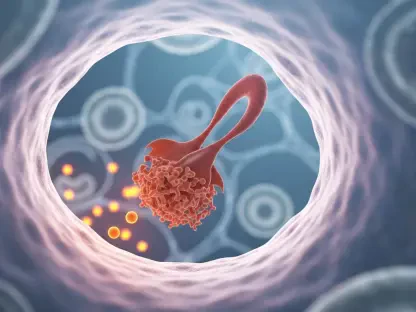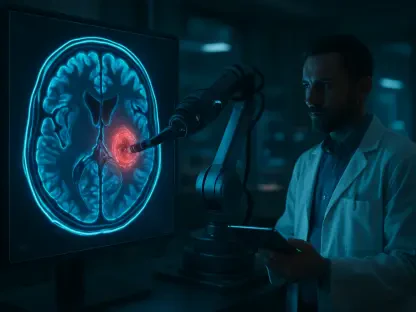What drives the extreme emotional rollercoaster of bipolar disorder, where manic highs can spiral into crushing depressive lows in a matter of days, leaving millions worldwide searching for answers? This question haunts not only those affected but also the scientists striving to unravel the brain’s deepest mysteries. At the Icahn School of Medicine at Mount Sinai, a groundbreaking research initiative, fueled by a $4.5 million grant from BD2: Breakthrough Discoveries for Thriving with Bipolar Disorder, is poised to change the game. This ambitious project aims to map the neural circuits behind these mood swings, offering a glimmer of hope for innovative treatments that could redefine mental health care.
The significance of this endeavor cannot be overstated. Bipolar disorder affects approximately 2.8% of the U.S. population, disrupting lives with unpredictable episodes that strain relationships, careers, and personal stability. Despite its prevalence, the neural mechanisms driving these mood shifts remain largely unknown, leaving many patients reliant on treatments that often fail to provide lasting relief. Mount Sinai’s research, led by top experts in neuroscience and psychiatry, targets this critical gap, seeking not just to understand the condition but to revolutionize how it is managed through cutting-edge technology and personalized approaches.
Peering into the Bipolar Brain: Why It Matters
Delving into the brain’s hidden wiring is no small feat, yet the urgency to do so has never been greater. With mental health challenges on the rise globally, bipolar disorder stands out as a condition that demands innovative solutions. The unpredictable nature of its symptoms often leaves patients and families grappling with uncertainty, while traditional medications fall short for many, especially those with treatment-resistant forms of the illness.
Mount Sinai’s initiative represents a pivotal step toward bridging this knowledge divide. By focusing on the neural underpinnings of mood transitions, the research aims to uncover actionable insights that could lead to therapies tailored to individual needs. This is not just about science for science’s sake—it’s about restoring stability and hope to countless lives affected by a disorder that remains poorly understood despite decades of study.
Cutting-Edge Strategies at the Forefront
At the heart of this project are two innovative research approaches, each designed to illuminate the brain’s role in bipolar disorder with unprecedented detail. The first, Deep Brain Stimulation (DBS), led by Dr. Helen Mayberg, Director of the Center for Advanced Circuit Therapeutics, involves implanting electrodes in mood-regulating brain regions of patients with bipolar depression. Over a year, the team collects a wealth of data through neural recordings, daily self-assessments, and MRI scans, aiming to correlate brain activity with shifts in emotional states.
Complementing this is the second approach, Stereotactic Electroencephalography (sEEG), directed by Dr. Ignacio Saez, Associate Professor of Neuroscience, Neurosurgery, and Neurology. This method studies patients with both epilepsy and bipolar disorder, using minimally invasive recordings to explore mood-related brain circuits. By comparing these findings with control groups, researchers hope to identify novel targets for therapeutic intervention, expanding the potential for effective treatments.
These strategies, supported by a multidisciplinary team of neurosurgeons, psychiatrists, and clinical experts, are not merely experimental. They aim to construct a comprehensive map of neural dysfunction in bipolar disorder, setting a foundation for therapies that could bypass the limitations of current pharmacological options. This dual-pronged effort underscores Mount Sinai’s commitment to pushing the boundaries of what is possible in mental health research.
Voices of Innovation: Expert Perspectives
The leaders behind this transformative work bring a wealth of expertise and optimism to the table. Dr. Saez emphasizes the unique position of Mount Sinai at the intersection of multiple disciplines, noting, “This program enables us to capture brain activity with a level of detail previously unimaginable, paving the way for therapies that could change lives.” His vision reflects a belief in the power of technology to unlock answers long out of reach.
Dr. Mayberg, a pioneer in circuit therapeutics, shares a similar enthusiasm for the potential of neuromodulation. “For many patients, traditional treatments offer little relief,” she explains. “Directly targeting specific brain circuits could be the breakthrough we’ve been searching for.” Her perspective aligns with a growing consensus in the field that neuromodulation might outshine conventional methods, especially for those who have exhausted other options.
These insights highlight a shared conviction among researchers: the future of bipolar treatment lies in precision and personalization. By combining advanced surgical techniques with detailed behavioral data, the team is not just studying the brain—they are redefining how mental health challenges are approached, offering a lifeline to those who need it most.
From Lab to Life: Translating Research into Reality
While the research is still in progress, the Mount Sinai team is already charting a path to turn scientific discoveries into tangible benefits for patients. One key goal is to pinpoint specific brain circuits linked to mood swings, which could serve as precise targets for neuromodulation therapies like DBS. Such findings might enable clinicians to intervene directly at the source of dysfunction, rather than relying on broad-spectrum medications with varying success rates.
Another focus is on personalizing care through the integration of clinical and neural data. By understanding each patient’s unique brain activity patterns, future treatments could be customized to match individual profiles, enhancing effectiveness. This approach promises to move beyond the one-size-fits-all model that often leaves patients frustrated and underserved.
Beyond immediate applications, the research could inspire entirely new tools and strategies for managing bipolar disorder. For those who currently face limited options, these advancements represent a potential expansion of choices, fostering a future where mental health care is both more accessible and more effective. This roadmap reflects a dedication to not just understanding the disorder, but ensuring that knowledge translates into real-world impact.
Reflecting on a Journey of Discovery
Looking back, the journey embarked upon by Mount Sinai with the support of the $4.5 million grant from BD2 marked a turning point in the fight against bipolar disorder. The relentless pursuit of answers through Deep Brain Stimulation and Stereotactic Electroencephalography illuminated paths previously shrouded in mystery. This work laid critical groundwork for understanding the neural chaos behind mood swings, even as it unfolded amidst the complexities of human brain research.
As the scientific community continues to build on these efforts, the next steps involve accelerating the development of targeted neuromodulation therapies. Stakeholders, from clinicians to policymakers, must prioritize funding and collaboration to ensure these innovations reach patients swiftly. The promise of personalized interventions beckons, urging a sustained commitment to transforming mental health care.
Moreover, the broader implications of this research remind everyone of the power of interdisciplinary approaches in tackling intractable challenges. The hope is that future initiatives will draw inspiration from this model, fostering partnerships that drive progress. For those living with bipolar disorder, the horizon holds the potential for treatments that truly adapt to their needs, a legacy of innovation worth striving for.









